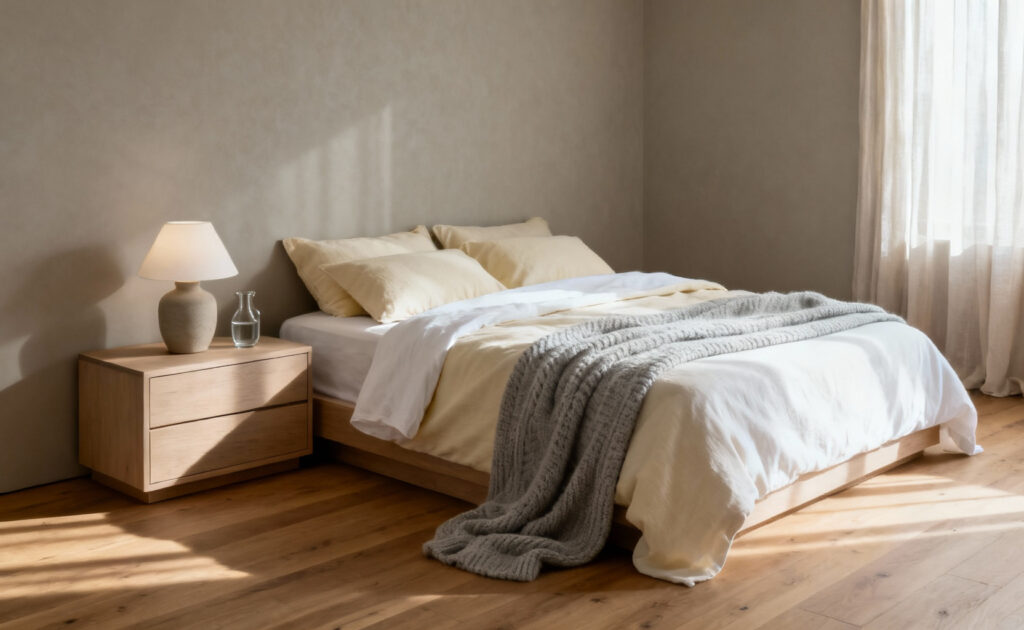As a wellness architect, I frequently walk into client bedrooms that look like they belong on the cover of a design magazine. The aesthetics are often flawless, featuring plush velvet headboards and perfectly curated nightstands, yet these clients frequently confess they feel exhausted. This contradiction is what I call “The Sanctuary Gap.” It represents the profound disconnect between a room that pleases the eye and a space that supports the biology of a sleeping body. While a room may be visually stunning, it often fails to provide the darkness, silence, and cool temperatures essential for deep, restorative rest. This highlights a critical flaw in modern bedroom interior design.
We often prioritize form over function, forgetting that our circadian rhythms rely on strict environmental cues. Your brain cannot appreciate a stylish lamp if the bulb emits blue light that suppresses melatonin, nor can your body cool down for slumber if the room hovers above the physiological ideal of 67°F. Furthermore, visual “mental clutter” keeps the mind active long after the lights go out. When we ignore these biological realities in favor of trends, we inadvertently design environments that fight against our natural sleep cycles rather than harmonize with them.
Closing this gap does not mean sacrificing style for sleep hygiene. In this article, we will explore how to align your bedroom design with your physiological needs to create a truly restorative environment. From installing blackout treatments that protect melatonin production to selecting cooling natural fibers, we will cover actionable steps to transform your space. By bridging the divide between aesthetics and wellness, you can build a sanctuary that looks inviting and helps you sleep.
Bedroom Interior Design: Moving from Decoration to Restoration
True design goes deeper than aesthetics; it shapes our biology. In my practice, I often see clients prioritize “Insta-worthy” trends that disrupt sleep patterns. To shift from mere decoration to true restoration, you must view your bedroom as a health tool rather than a showcase. Start by ruthlessly eliminating cognitive stress triggers to create a radically “unbusy” space.

- Institute a “No Open Clutter” rule: Use nightstands with drawers to hide visual noise and keep surfaces clear.
- Master your lighting: Install dimmers and use shaded, warm-toned lamps to gently signal the brain that it is time to wind down.
- Layer organic textures: Incorporate tactile materials like linen or weathered wood against earth-toned walls to induce a “cocooning” effect.
Through these changes, the room transforms into a sanctuary. By prioritizing tactile warmth and visual silence over fleeting fashion, you build the necessary foundation for deep, physical recovery.
Phase 1: The Biological Foundation (Optimizing for Health)
True wellness design begins where the eye cannot see: with your biology. I treat the bedroom as a recovery chamber for your physiological systems rather than just a space for decor. To build this foundation, you must actively manipulate the environment to support deep rest. Start by synchronizing your room with your circadian rhythm. Install blackout shades to banish artificial light, effectively protecting your natural melatonin production. Once the room is dark, focus on the air and atmosphere:

- Regulate temperature: Keep the thermostat between 65–68°F (18–20°C) to facilitate the body’s necessary thermal drop.
- Purify the air: Introduce a high-quality air filter or purifying plants like bamboo palms.
- Choose natural materials: Select low-VOC paints and organic bedding to minimize chemical inhalation.
- Prioritize breathable textures: Swap synthetic sheets for cotton or wool to aid thermoregulation.
By aligning your space with these biological needs, you transform your bedroom from a sleeping area into a sanctuary for cellular repair.
1. The Circadian Lighting Scheme: Layering warm-dim technology to mimic natural sunsets
Your body’s internal clock relies on natural light cues to regulate sleep hormones. Standard bright white bulbs disrupt this delicate rhythm by suppressing melatonin, the chemical that helps you drift off. Instead, embrace a “Circadian Lighting Scheme” that physically mimics a natural sunset within your bedroom. Start by swapping static bulbs for warm-dim technology. Aim for a Color Correlated Temperature (CCT) of 2700K to 3000K for your early evening ambiance, as this warm, reddish glow signals your brain to unwind.

Design your lighting layers to descend alongside your energy levels. Implement this three-stage routine to prepare for deep rest:
- Two hours before bed: Switch off all overhead ambient lights. Transition to lower, dimmer sources like table lamps or wall sconces.
- One hour before sleep: Engage the “Flame Warm” setting. Drop light intensity to the lowest level, ideally below 1800K, to mimic candlelight.
- Throughout the evening: Consider “tunable white” smart systems to automate this shift.
These systems seamlessly adjust color and brightness, aligning your home with nature’s clock without manual effort, effectively turning your environment into a tool for better health.
2. Breathable Architecture: Selecting organic, low-VOC paints and wall treatments
Treat your bedroom walls as a third skin; they surround you while your body performs its critical nightly repair work. Standard synthetic paints often off-gas invisible chemicals that disrupt this delicate process. I urge clients to look past generic “low-VOC” labels, since toxic solvents frequently sneak in during the tinting stage. Instead, demand Zero-VOC certified formulas tested *after* color addition to ensure the air you breathe remains pure.
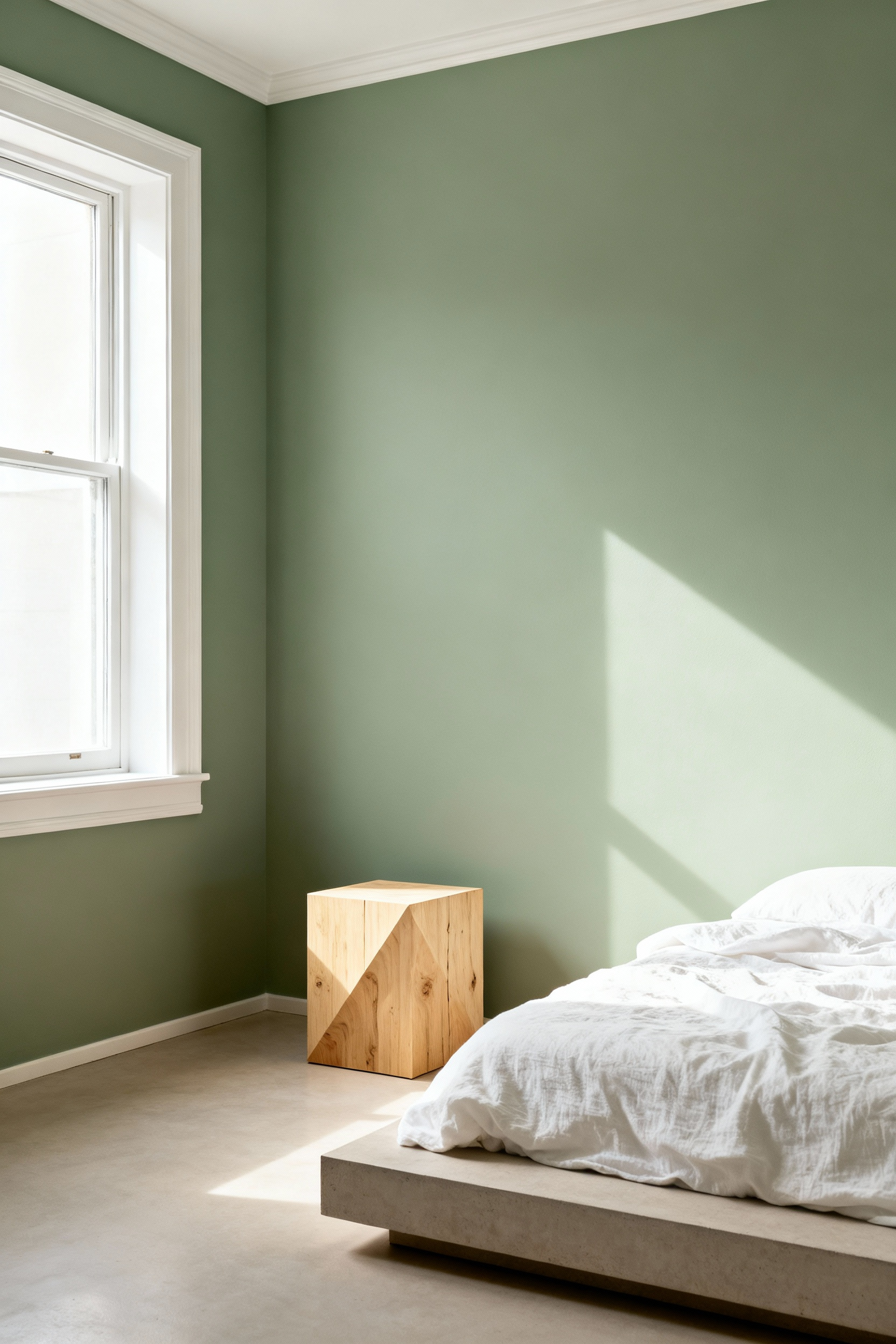
However, true breathable architecture goes beyond simple paint. To actively regulate humidity and prevent mold, consider swapping synthetics for living mineral finishes:
- Clay Plaster: Absorbs and releases moisture naturally to balance indoor humidity levels.
- Limewash: Uses high alkalinity to create a naturally antimicrobial, bacteria-resistant surface.
These earthy, muted materials apply easily over existing drywall, allowing you to transform your sleep sanctuary without a chaotic renovation.
3. The Oxygenated Corner: Specific air-purifying plants that thrive in low bedroom light
Transform your bedroom into a restorative sanctuary by curating a purposeful “Oxygenated Corner.” Rather than simply filling space, prioritize plants that actively support your circadian rhythms. Start with the Snake Plant on your nightstand; unlike most flora, it releases oxygen at night to fuel deep sleep. For dim, empty floor areas, deploy the resilient ZZ Plant or Peace Lily. These botanical powerhouses scrub airborne toxins like formaldehyde without demanding constant sunlight or water, allowing you to breathe cleaner air with minimal effort.
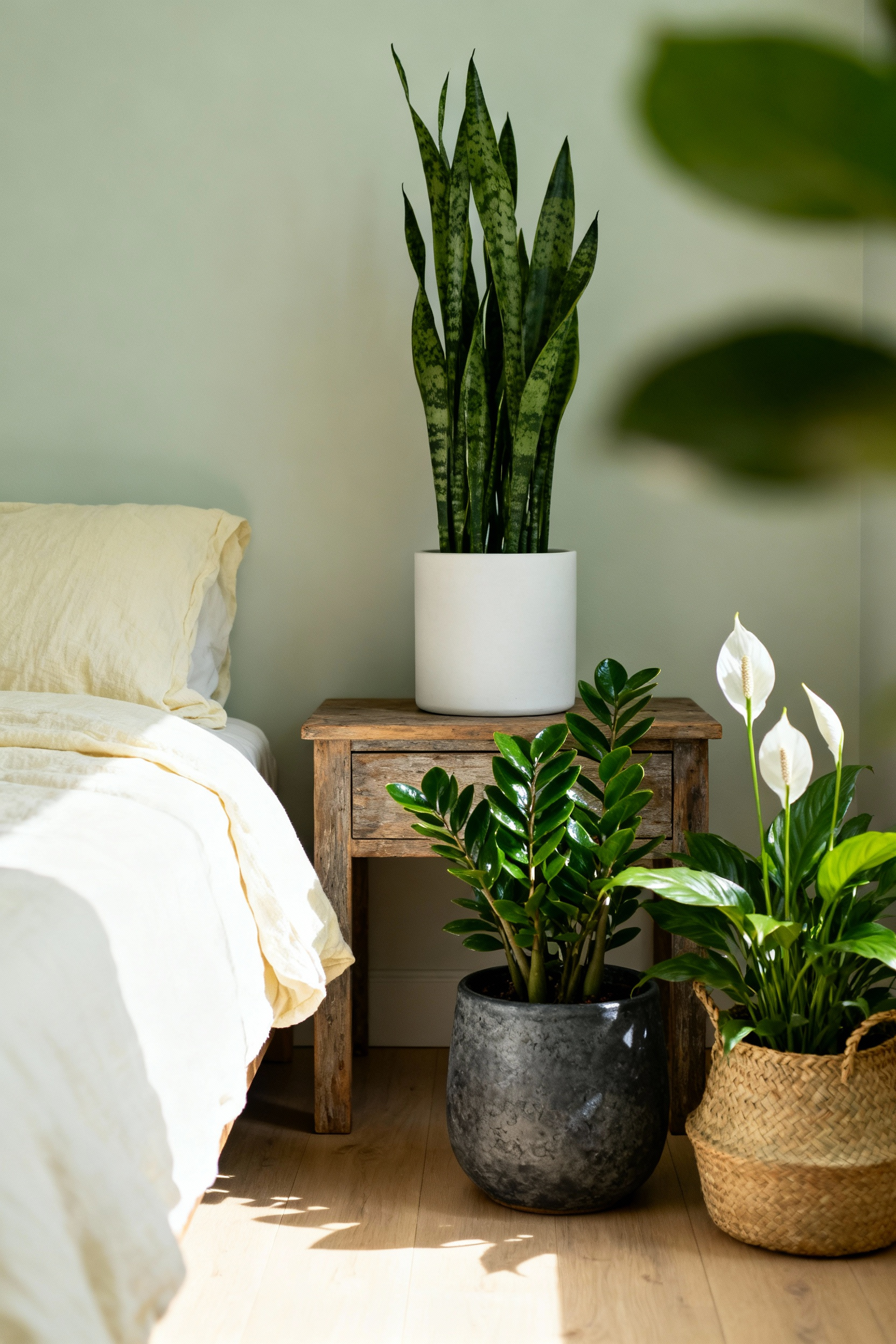
Holistic design requires balancing aesthetics with safety. While tall Bamboo Palms can soften rigid architectural lines, you must select varieties that protect your entire household. Before purchasing, categorize your options based on your living situation:
- Pet-Safe: Opt for the Spider Plant or Bamboo Palm if cats or dogs share your space.
- Caution Required: Avoid English Ivy and Pothos, which are toxic if ingested.
- Styling: House your greenery in textured ceramics or woven baskets to match your decor.
This approach grounds the organic elements within your room, ensuring your space feels as healing as it looks.
4. EMF-Conscious Layouts: Positioning the bed away from active wiring and digital noise
Treat the bed as a sanctuary for cellular repair. To support this, swap metal bed frames and coil mattresses for solid wood or non-metal options. Metal components often act as antennas that amplify ambient electromagnetic fields (EMFs). Furthermore, pull your bed 8 to 15 inches away from the wall. This simple shift reduces exposure to the magnetic fields emitted by internal wiring and dimmers. Finally, verify that your headboard does not back up to high-voltage sources like circuit breakers or refrigerators.
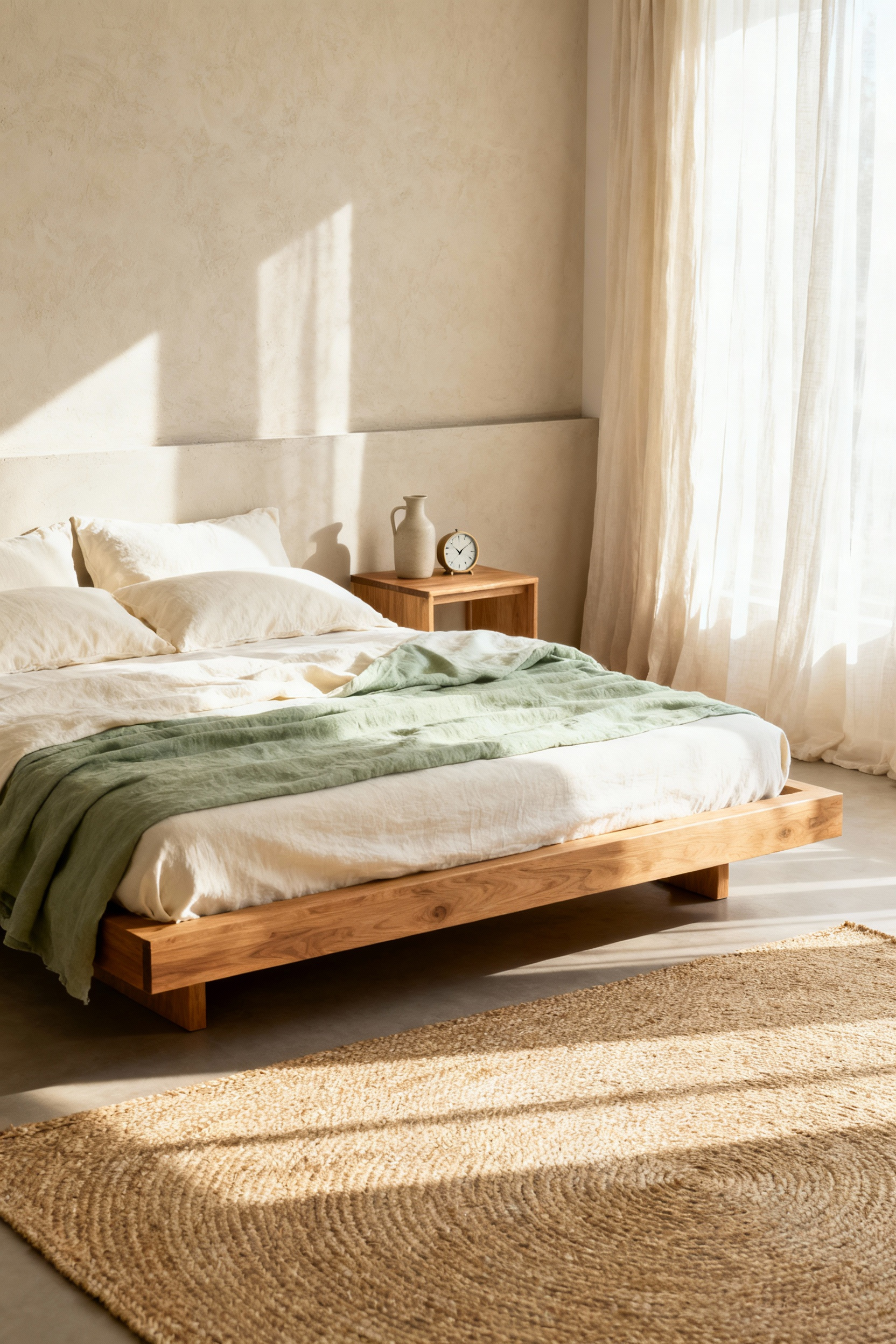
Next, address airborne digital noise to further protect your sleep quality. Because EMF intensity drops sharply with distance, establish a strict six-foot buffer between your body and any electronics. To deepen this “low-tech zone,” implement these simple upgrades:
- Clear the perimeter: Move chargers, televisions, and power strips outside the six-foot zone or into another room entirely.
- Automate silence: Use a plug-in timer to turn off your Wi-Fi router automatically at bedtime.
Eliminating this radio frequency radiation ensures your nervous system truly rests.
5. Thermal Regulation: Why natural fibers (linen, wool, bamboo) are essential design elements
Your body’s core temperature must drop to initiate deep restorative sleep, but fluctuating room conditions often disrupt this delicate physiological process. To support your circadian rhythm, reject synthetic blends that trap heat and suffocate the skin. Instead, build your sleep sanctuary with active, natural fibers like wool or bamboo. Anchor your bedding with a wool-filled duvet; it possesses a dual intelligence, acting as an insulator during winter chills yet breathing efficiently to prevent overheating in summer. This balance creates a stable microclimate around your body, effectively eliminating the need for seasonal bedding swaps.
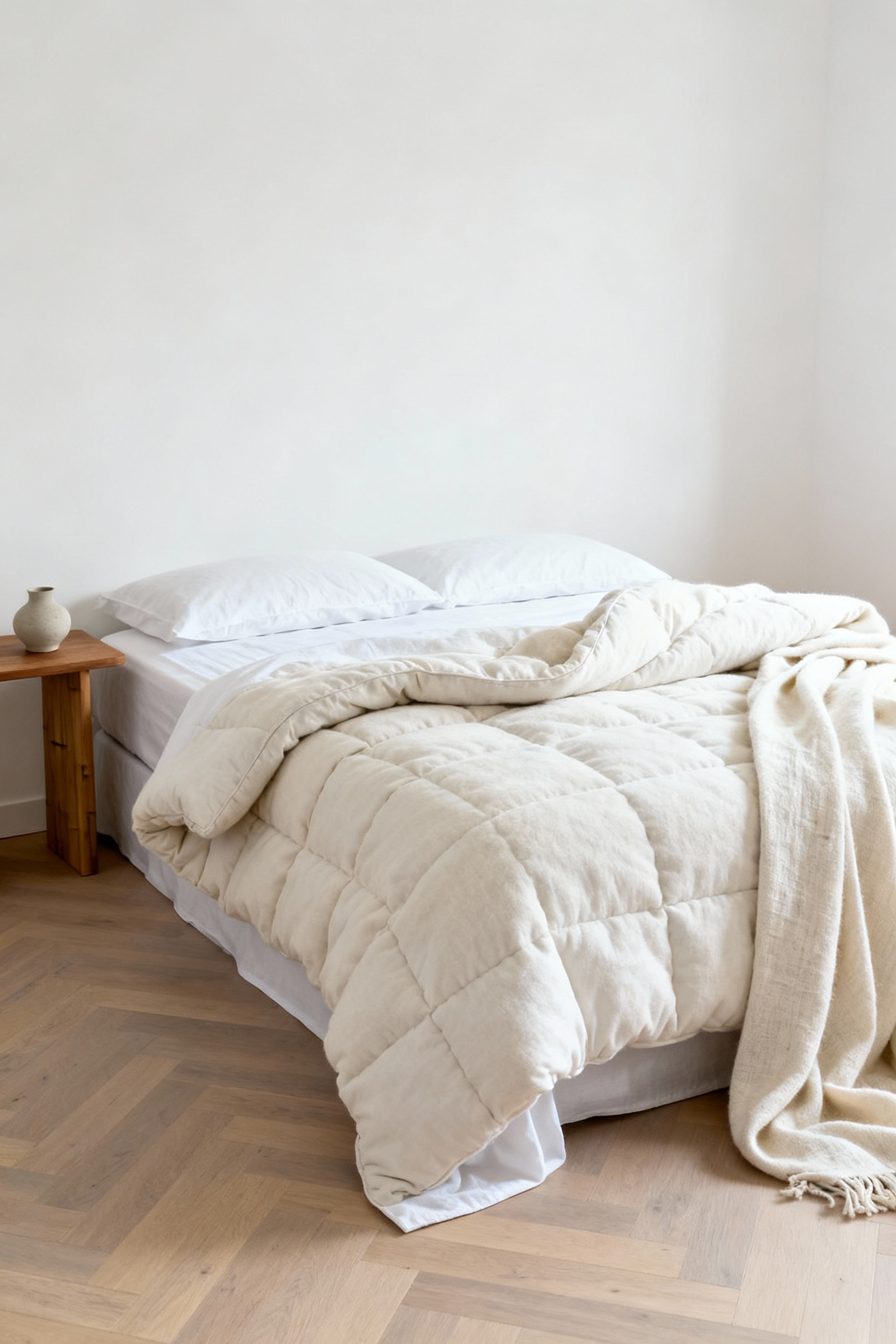
Beyond the duvet, specific textures address individual sensitivities. I have seen clients with chronic sleep disruptions find relief simply by adjusting their textile layering. Implement these material solutions for targeted thermal control:
- Select Linen: Use this for top sheets if you run hot, as the loose weave allows heat to dissipate instantly.
- Prioritize Bamboo: Choose bamboo sheets for superior moisture-wicking to ensure a dry, sweat-free night.
- Ground with Wool: Place a wool rug under the bed to insulate the floor, keeping the room warm in winter while preventing clamminess in summer.
By harmonizing these elements, you transform your bedroom into a responsive environment that actively protects your rest.
Phase 2: Spatial Psychology (Layout and Feng Shui)
Your furniture arrangement directly communicates with your nervous system. I often find clients unknowingly spiking their cortisol levels simply by facing their bed away from the entrance. To cultivate true safety, adopt the “Commanding Position.” Anchor your headboard against a solid wall where you can view the door without aligning directly with it. This placement satisfies your primal brain’s need for security, reduces subconscious vigilance, and allows you to drop into a deeper restorative state.

Ensure energy flows smoothly around your resting space to maintain a sense of calm.
- Build symmetry: Use matching nightstands and lamps to foster visual balance and psychological stability.
- Clear the sub-floor: Keep the area under your bed empty to allow *Chi* to circulate and prevent stagnant energy from disrupting sleep.
- Redirect reflections: Move mirrors to side walls to stop excessive energy from bouncing back at you while you rest.
These precise shifts align your environment with your biology, turning your bedroom into a sanctuary for health.
6. The ‘Command Position’: Orienting the bed for subconscious security and reduced anxiety
I often enter bedrooms that inadvertently trigger low-level anxiety simply due to orientation. Your nervous system constantly scans for threats, so you must signal safety to your subconscious to achieve deep restorative sleep. The most effective method is the “Command Position,” a layout that balances visibility with protection. To quiet your limbic system and invite calm, arrange your furniture using these principles:

- Anchor diagonally: Place your bed across the room from the door, providing a clear view of the entrance without aligning directly with it.
- Seek refuge: Rest your headboard against a solid wall rather than a window to foster a sense of grounding.
- Avoid the “coffin position”: Never point your feet directly out the door, as this disrupts energy flow and creates vulnerability.
If your room’s architecture prevents this ideal setup, place a mirror to reflect the doorway from your pillow. This simple adjustment restores your visual control. Consequently, your brain stops monitoring the environment for danger and finally allows you to drift into a truly peaceful state.
7. The Psychology of Symmetry: Balancing nightstands to create visual and mental equilibrium
Your brain naturally seeks patterns to conserve energy. Design for this neural preference, as visual order directly lowers cortisol levels. Establish *formal symmetry* by flanking your bed with identical nightstands and matching lamps. This arrangement reduces cognitive load, allowing your mind to process the room instantly without effort. As a result, your nervous system receives a clear signal of stability, helping you downshift into a state of deep mental rest.
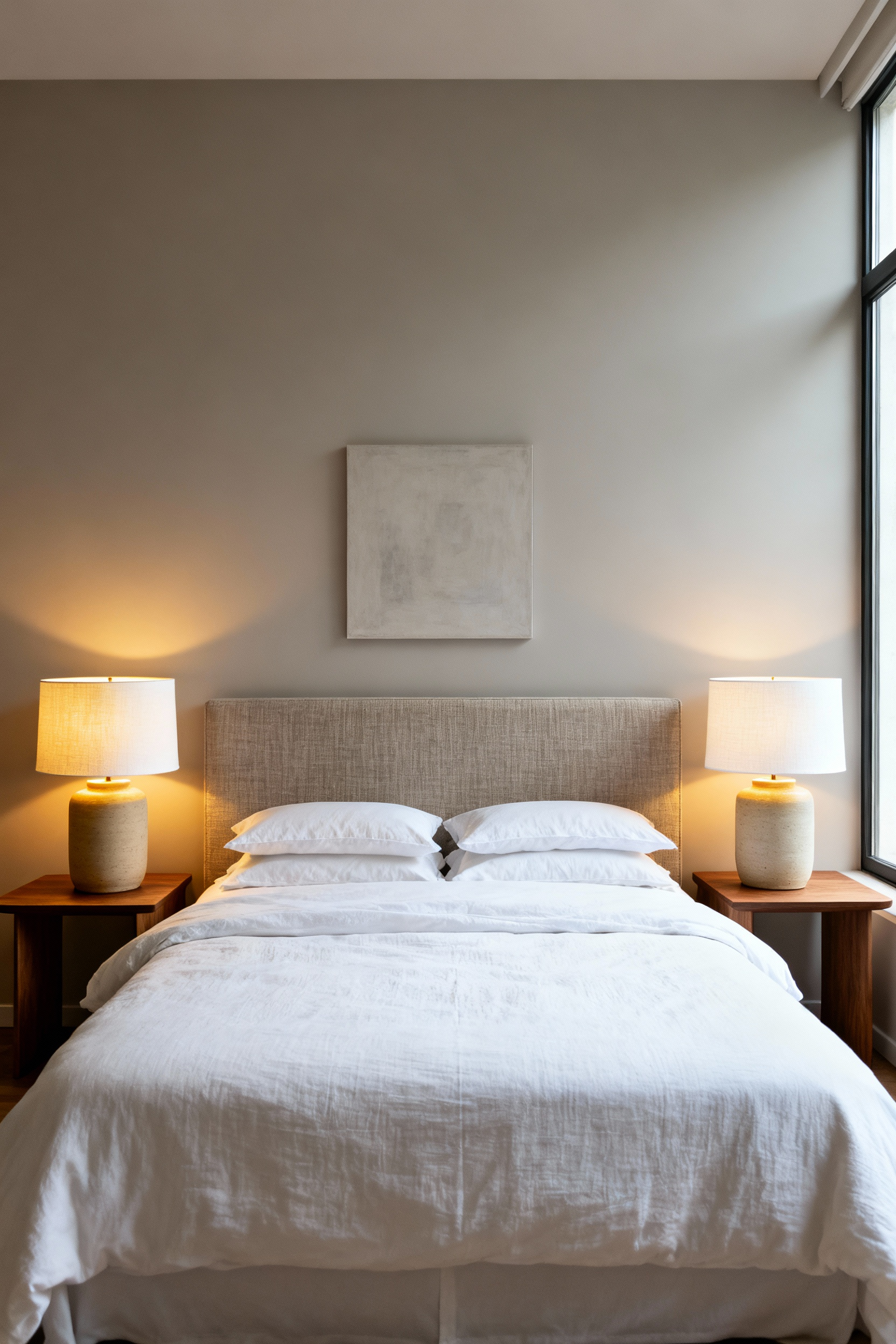
If you prefer a modern aesthetic, achieve equilibrium through *asymmetrical balance* instead. You might pair a vintage chest with a sleek accent table, but ensure they share a similar visual weight or height to prevent the room from feeling lopsided. To maintain a sense of calm with mismatched pieces, apply these grounding principles:
- Anchor with lighting: Use a pair of matching wall sconces or table lamps to create a strong visual rhythm that ties the disparate pieces together.
- Prioritize equality: Ensure both sides offer equal surface area so partners feel equally supported.
This intentional balancing act creates a cohesive focal point, promoting both visual rhythm and relationship harmony.
8. Visual Silence: Closed storage solutions to reduce cortisol-spiking clutter
Your eyes function as an optical extension of your brain, meaning every exposed object in your bedroom demands mental energy to process. Even neatly arranged open shelving can overwhelm the senses and keep cortisol levels elevated. True restoration requires “visual silence.” I guide clients away from open displays and toward “aesthetic containment.” This approach quiets the room, allowing your nervous system to downshift the moment you cross the threshold.

To achieve this, prioritize furniture that completely conceals its contents. Swap open-leg side tables for nightstands with solid drawers and replace floating shelves with floor-to-ceiling cabinetry. Furthermore, maximize hidden utility to keep surfaces clear:
- Utilize Storage Beds: Choose frames with built-in drawers or lift-up compartments to hide seasonal bedding.
- Contain Small Items: Place chargers and lotions inside lidded woven baskets or opaque boxes.
- Divide and Conquer: Install drawer dividers to prevent internal chaos from becoming a hidden source of stress.
By tucking belongings out of sight, you eliminate the visual chatter that disrupts sleep. Ultimately, a quiet room fosters a quiet mind.
9. The Grounding Headboard: Using solid upholsteries to create a sense of psychological support
View the bed as a sanctuary requiring profound protection. Sleep places us in a vulnerable state, so our environment must offer subconscious security. Create this safety through a “Grounding Headboard.” Select a design that acts as a sturdy visual barrier. Prioritize scale; extend the frame high above and inches beyond the mattress width. This mass provides a psychological anchor, grounding you in the room and signaling safety to your nervous system.
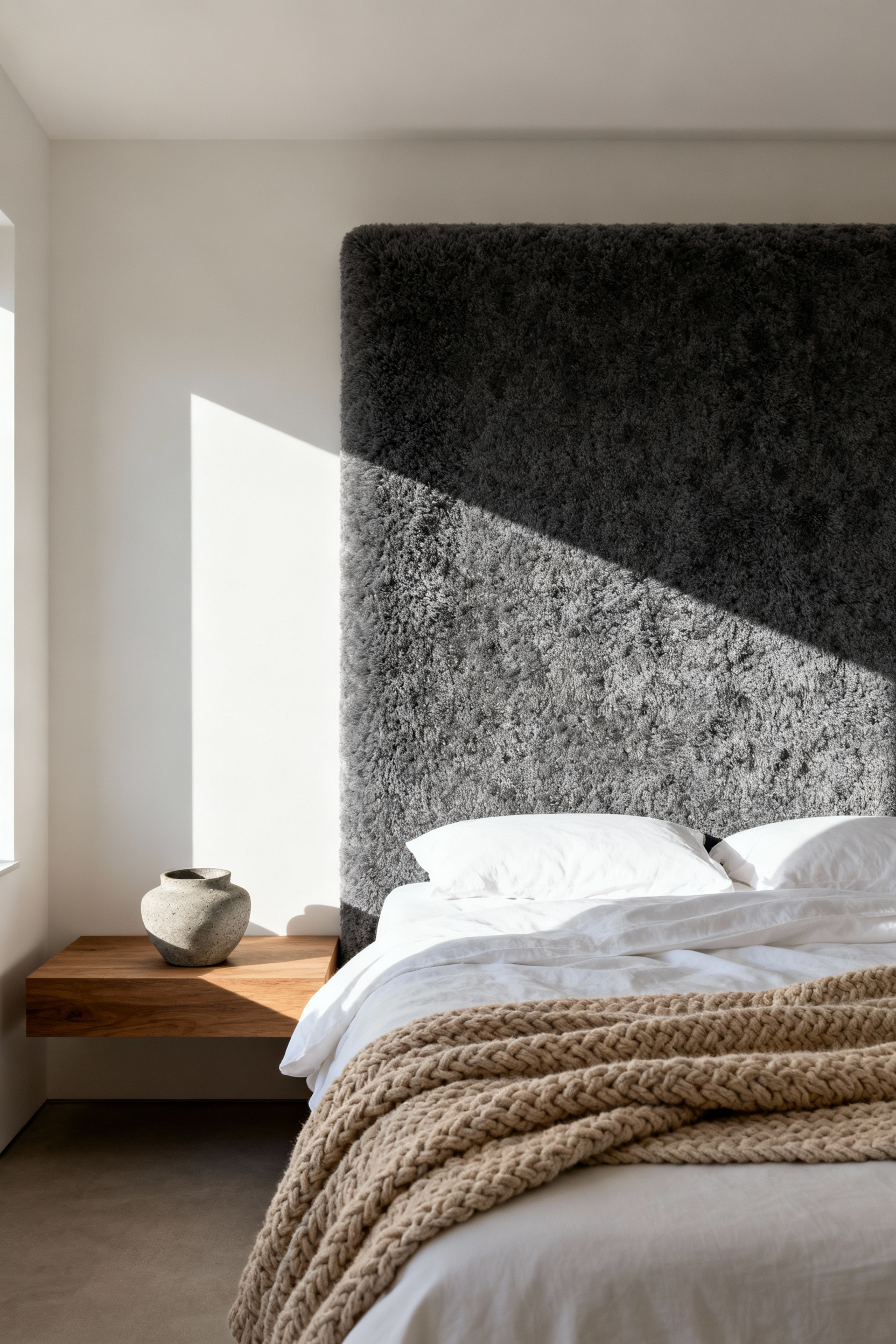
Engaging the senses enhances this protective effect. Avoid busy patterns that stimulate the eye. Instead, rely on heavy, solid-colored textiles to dampen sound and insulate against cold walls.
- Velvet or chenille adds deep, tactile warmth.
- Thick linen provides organic texture.
- Tweed offers structured durability.
Simple, rectangular forms reinforce this sense of order. By combining robust acoustic properties with geometric stability, you build a cocoon that actively supports deep, restorative rest.
10. Flow Dynamics: Ensuring clear pathways to prevent physical and mental stagnation
Your bedroom environment mirrors your internal state; physical obstacles create mental friction. To cultivate peace, you must eliminate stagnation. Start by establishing the “Command Position,” placing your bed diagonally across from the door with a solid wall behind the headboard. This layout fosters deep, subconscious security by offering a clear view of the entrance without direct exposure to the doorway’s rushing energy. Sleep anxiety often decreases simply by shifting the bed out of a direct, high-traffic pathway.
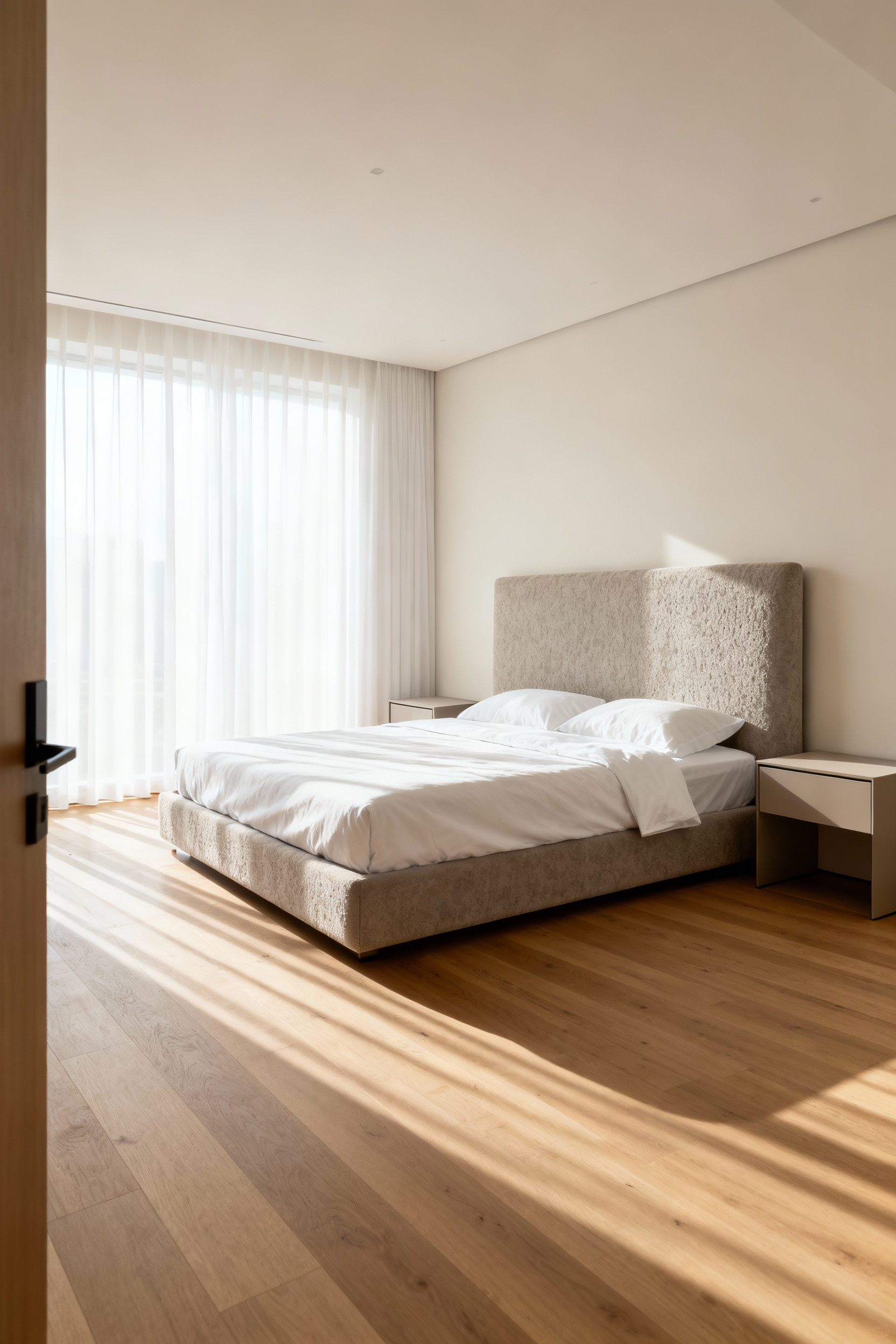
Next, aggressively clear the arteries of the room. Clutter acts as a dam, stopping the smooth flow of restorative energy (Chi). To ensure your space supports both movement and mind, adhere to these spatial rules:
- Maintain at least 24 inches (60 cm) of clear walkway around the bed.
- Keep the area under the bed completely empty to allow air to circulate.
- Widen main paths to the door or bath to 36 inches (90 cm).
These adjustments remove invisible stressors. By softening sharp furniture angles and opening these walkways, you invite tranquility rather than frustration into your daily routine.
Phase 3: The Sensory Envelope (Texture and Atmosphere)
True restorative design requires constructing a “sensory envelope” that creates safety for your nervous system. Flat, one-dimensional rooms often subconsciously heighten anxiety. To counter this, master the art of texture layering. Pair smooth, crisp cotton sheets with heavy, tactile fabrics like chunky knits or velvet to create physical and visual depth. Furthermore, extend this softness to the room’s perimeter. Use plush rugs and textured wall finishes, such as grasscloth, to diffuse sound and absorb harsh glare. These choices minimize sensory stressors and create a protective cocoon.
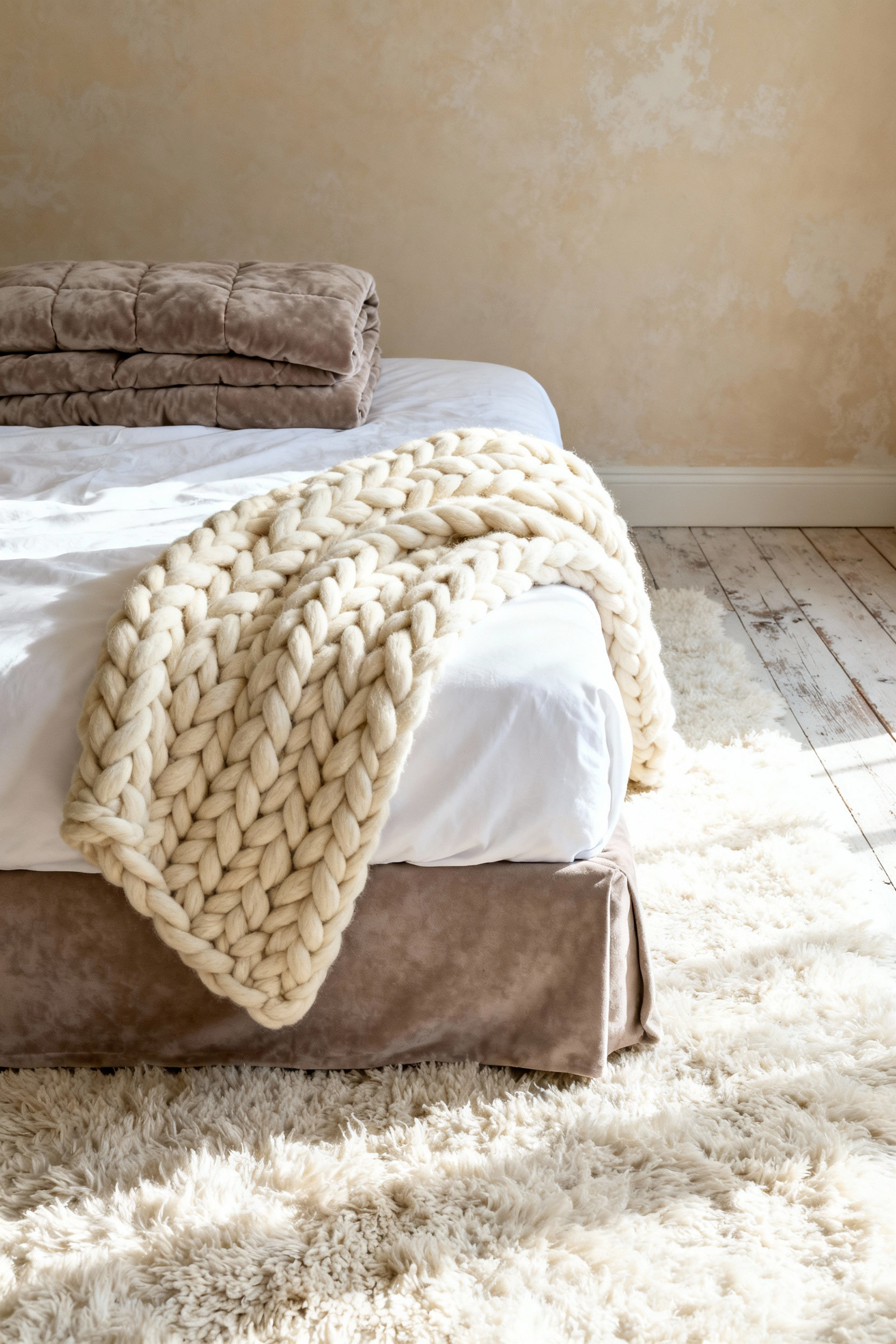
Once the foundation is set, curate the atmosphere to support your biological rhythms. Harsh overhead lighting disrupts melatonin production, so replace the “big light” with a layered strategy:
- Create pockets of warmth using low-level bedside lamps or wall sconces.
- Select warm bulbs that cast a golden glow to mimic the setting sun.
- Integrate scent using a diffuser with lavender or vanilla to bypass the logic brain and signal immediate relaxation.
By harmonizing sight, sound, and scent, you transform your bedroom from a simple sleeping space into a tool for holistic recovery.
11. Acoustic Softening: Using heavy drapes and plush rugs to dampen noise pollution
Your bedroom should soothe your nervous system, yet hard surfaces act as acoustic mirrors that bounce noise and induce subtle stress. To absorb these internal reflections, ground your space with a large, high-pile wool rug. Ensure the pile height exceeds 10mm and always anchor it with a thick felt pad. This simple addition doubles the sound-dampening power and stops footfall noise from disrupting your peace.
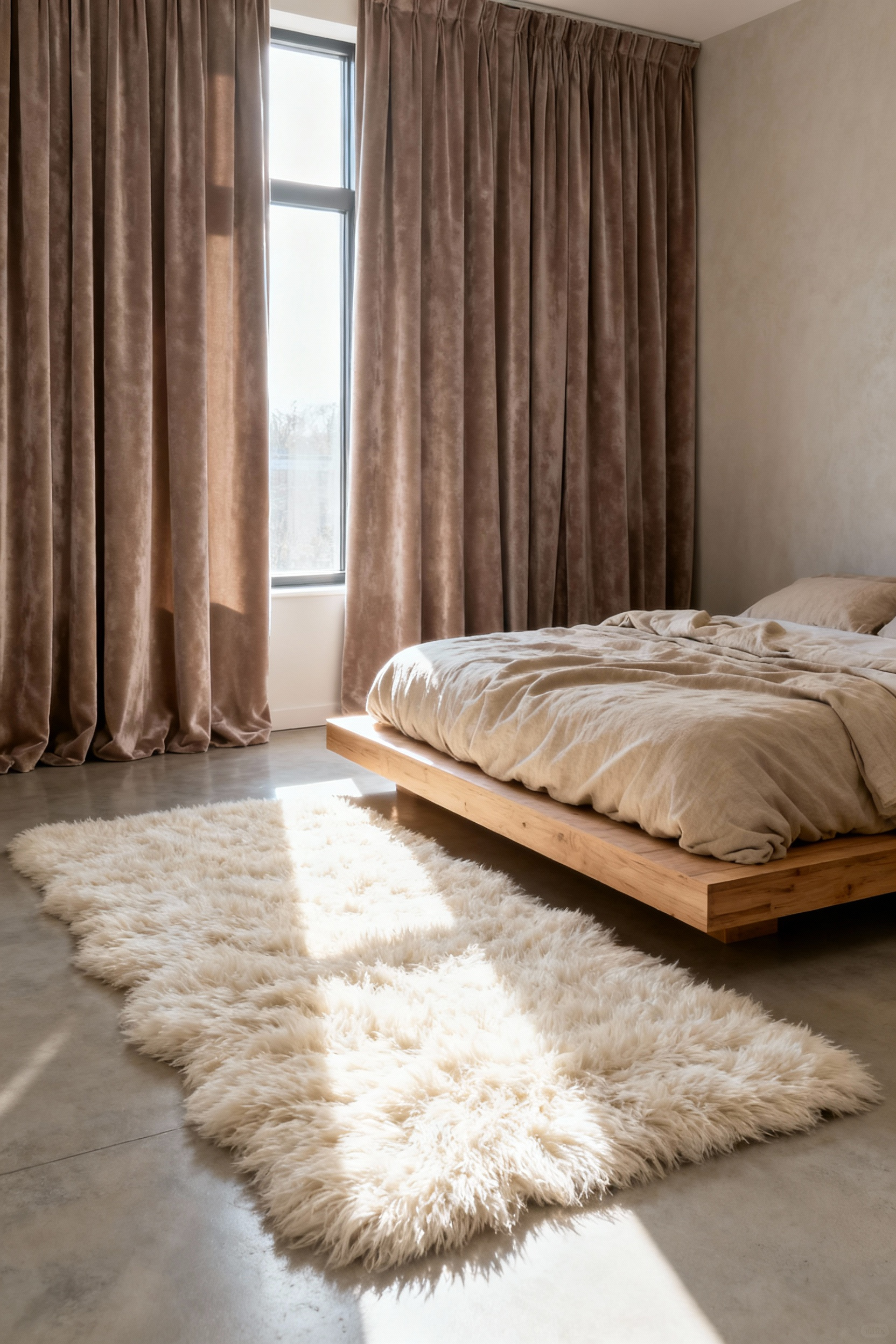
Treat your windows as the primary defense against external chaos. Clients often dramatically improve their sleep quality simply by upgrading to heavy, dense drapery. To create a true acoustic cocoon, prioritize these installation techniques:
- Select Dense Materials: Choose velvet, wool, or heavy cotton duck to effectively block sound waves.
- Maximize Coverage: Hang drapes from floor to ceiling and extend the rod past the window frame to seal gaps.
- Layer Textiles: Incorporate an upholstered headboard or plush cushions to scatter high-frequency sounds.
This density creates a palpable sense of safety, signaling to your brain that it is safe to deeply rest.
12. Tactile Zoning: Contrasting cool sheets with warm, chunky throws for sensory engagement
Your skin serves as a direct line to your nervous system, so utilize “Tactile Zoning” to engineer a deeper, more restorative sleep state. This design technique juxtaposes temperature and texture to satisfy the body’s dual need for thermal regulation and physical security. First, prioritize a base of crisp, cool-to-the-touch fabrics like Tencel or high-quality percale cotton to keep your basal body temperature low. Then, immediately contrast this smoothness with a heavy, chunky throw positioned at the foot of the bed. The distinct difference between the crisp sheets and a dense, warm wool or faux fur blanket offers a grounding sensation, allowing you to easily adjust your thermal comfort without overheating.
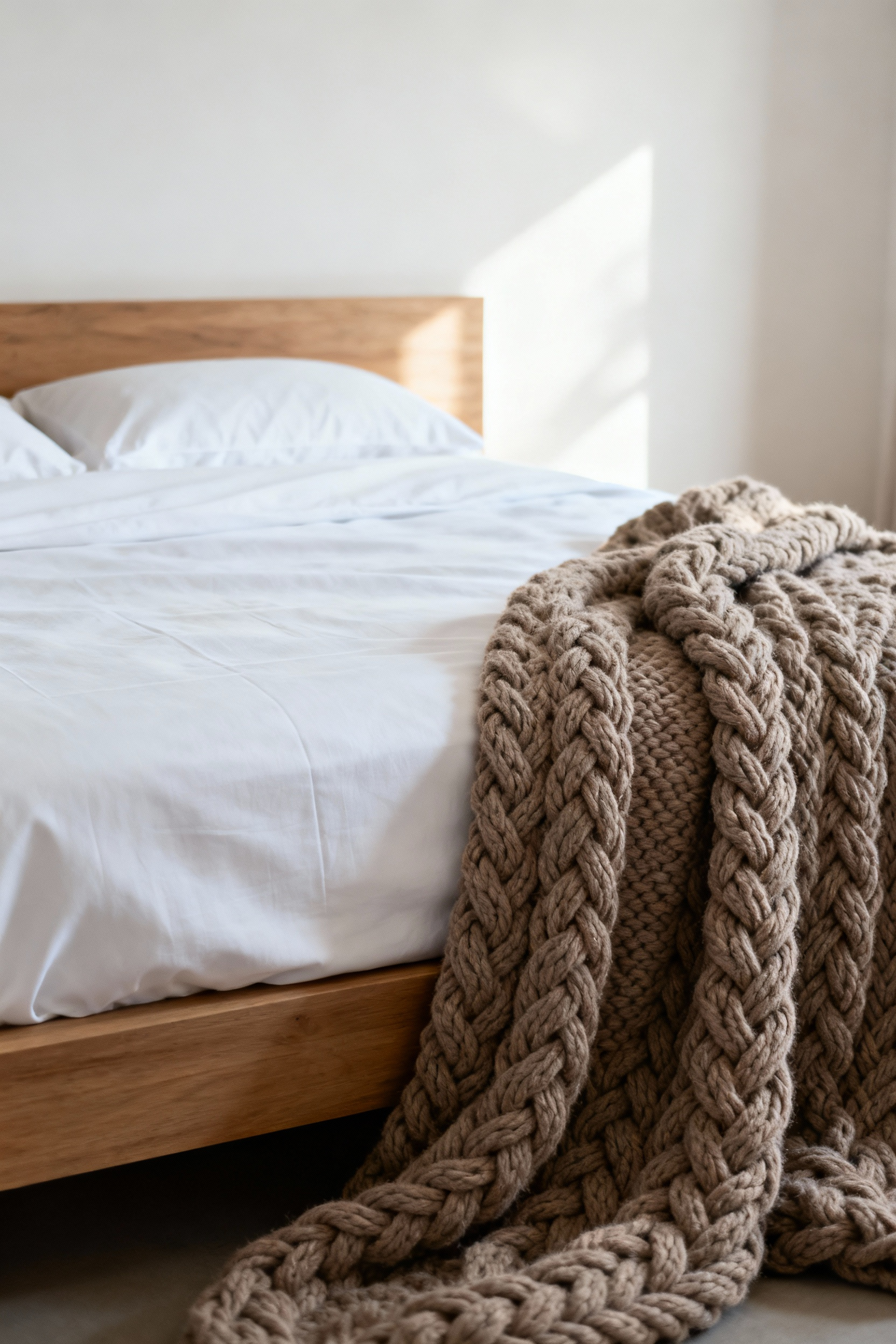
This intentional sensory engagement significantly reduces bedtime anxiety. The tangible shift from cool sheets to a warm, textured surface acts as a psychological cue for rest. To create this therapeutic environment:
- Anchor the Base: Use breathable percale for direct skin contact.
- Add Visual Weight: Select a throw with exaggerated texture, such as a chunky cable knit.
- Layer for Utility: Fold the warm layer at the very foot of the bed for immediate accessibility.
Ultimately, this layering strategy adds sophisticated visual depth while transforming your bed into a functional tool for mindfulness.
13. The Low-Stimulation Palette: Selecting desaturated hues that lower heart rate
Your bedroom walls communicate directly with your nervous system. To signal deep rest, curate a palette of desaturated, cool hues like soft blues, muted sages, or light lavenders. Research links these specific wavelengths to lowered heart rates and reduced blood pressure, physically priming your body for sleep. Conversely, high-intensity colors like bright red or vivid yellow trigger alertness and should be banished from the sleeping quarters. Therefore, seek out “muddy” or toned-down versions of your favorite colors to dampen visual vibration.

The paint finish is just as critical as the color itself. Treat light absorption as a design tool:
- Choose flat or matte paints: These finishes absorb light rather than reflecting it, creating a softer, sleepier atmosphere.
- Maintain low contrast: Avoid jarring transitions like black against white; instead, use a monochromatic scheme.
- Ground with neutrals: Incorporate warm beiges or taupes in bedding to prevent the room from feeling clinically cold.
By harmonizing these elements, you create a restorative backdrop that allows your eyes—and your mind—to relax instantly.
14. Blackout Aesthetics: integrating light-blocking layers without sacrificing style
True restorative sleep relies on complete darkness to regulate your circadian rhythm and boost melatonin production. Fortunately, you can achieve this biological necessity without hanging unsightly industrial fabrics. Select blackout panels in luxurious, sound-dampening textures like velvet or dense linen to add sensory warmth to your sanctuary. I invariably recommend installing double tracks to layer these heavy outer drapes over airy sheers. This approach provides diffused natural light for daytime vitality and total isolation for nighttime recovery.
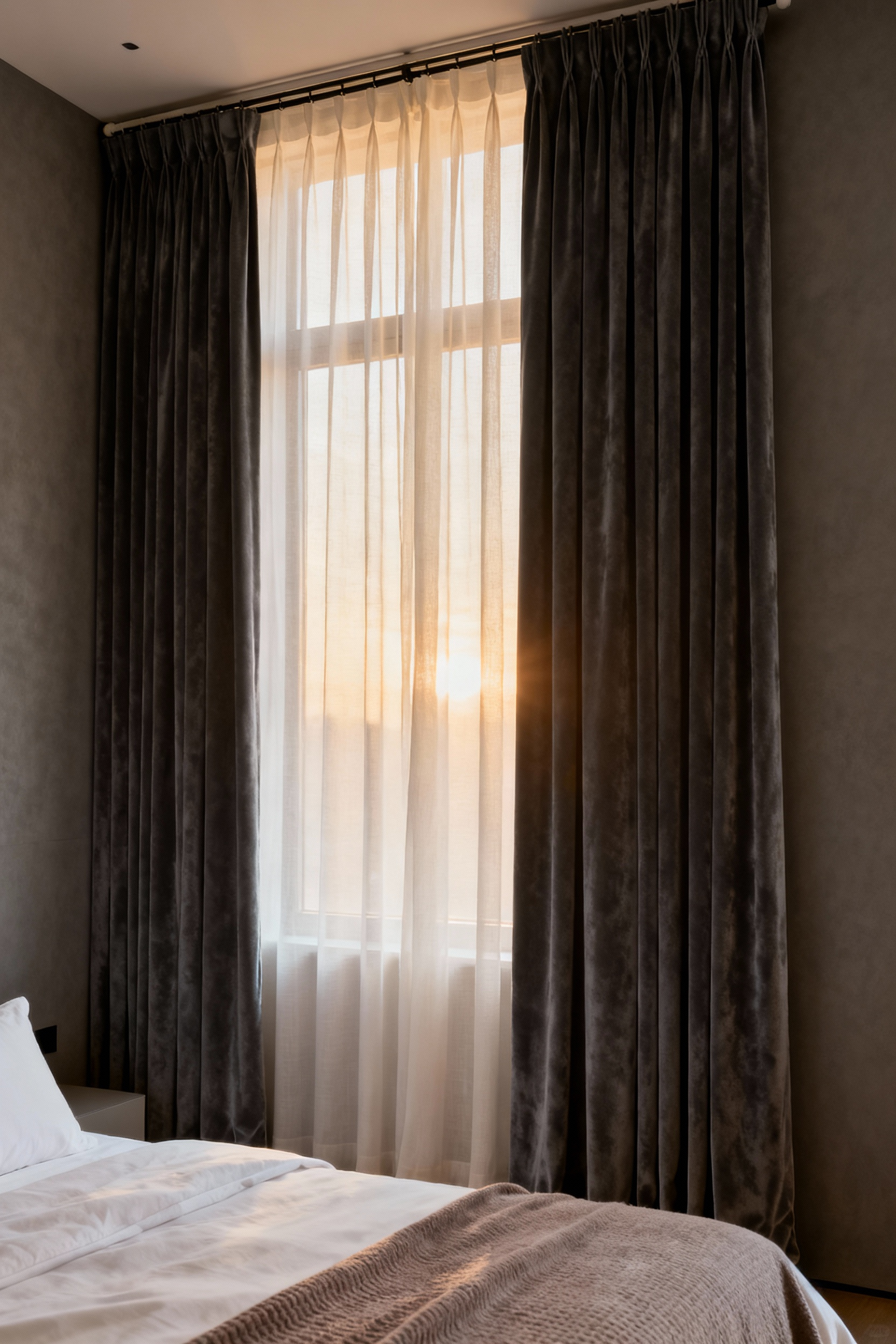
Precise installation prevents sleep-disrupting light leaks. Adhere to these placement rules for maximum efficacy:
- Mount High: Place rods 6 to 12 inches above the frame to create the illusion of height.
- Extend Wide: Let fabric hang 8 to 12 inches past the window sides to block peripheral streetlights.
- Seal Edges: If using roller shades, select models with side channels to eliminate gaps.
By treating your window coverings as a functional sleep system, you create a space that actively supports your physical health while maintaining a sophisticated aesthetic.
15. Scent-Scaping Design: Dedicating surface area for aromatherapy and calming rituals
Harness the direct connection between your olfactory system and the brain’s limbic system by creating a dedicated “aromatherapy nook.” Clear a specific surface on your dresser or nightstand to host your scent tools, ensuring they have space to breathe without overpowering your pillow area. Select diffusers or candle vessels that double as sculptural decor, merging functionality with your room’s aesthetic.
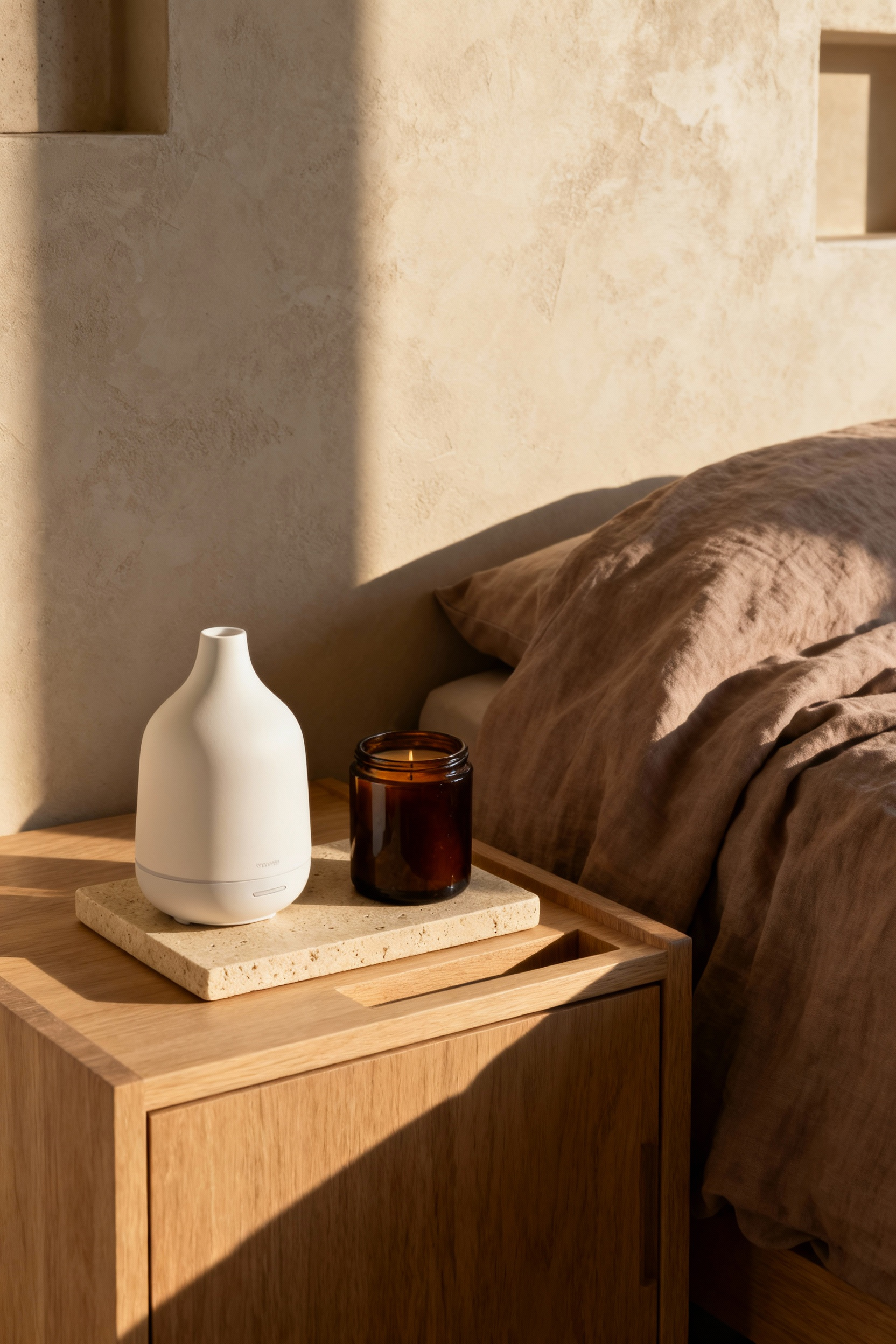
Establish a nightly ritual that signals the body to shut down. Unlike the invigorating citrus scents used in your kitchen, your bedroom requires a sedative palette to trigger relaxation. Consider these grounding options:
- Lavender to scientifically lower heart rate and reduce stress.
- Sandalwood or Cedarwood for deep, earthy stability.
- Jasmine for a soft, anxiety-reducing floral note.
Finally, transition from passive diffusion to active preparation. Spritz a linen mist onto your pillows ten minutes before bed; this sensory cue trains your mind that deep restoration is imminent.
Frequently Asked Questions about Bedroom Interior Design
What colors are considered the most relaxing for a bedroom?
The most relaxing colors are highly desaturated, cool hues, such as soft, muted sage greens, dusty blues, light lavenders, and cool greys (greige). These low-stimulation colors are scientifically proven to help lower heart rate and blood pressure, signaling the body that it is safe to rest. Avoid high-contrast or high-intensity colors like bright reds, yellows, or oranges, which can elevate alertness.
How do I make my small bedroom interior design look bigger?
To maximize space in a small room, employ floating or wall-mounted storage to keep the floor clear. Use a monochromatic color palette (one color family) and incorporate reflective surfaces, such as a large mirror placed across from a window to bounce light. Opt for a low-profile platform bed rather than a bulky frame to visually increase ceiling height and floor area.
According to Feng Shui, where is the ideal placement for a bed?
Feng Shui principles suggest placing the bed in the “Command Position.” This means the bed should be anchored against a solid wall (not a window) and positioned diagonally across the room from the entrance door. This layout allows you to clearly see anyone entering the room without being directly aligned with the doorway, fostering a subconscious sense of safety and security.
Should I eliminate technology entirely from my sleeping area?
Yes, for optimum sleep quality, wellness architecture recommends eliminating all technology that emits blue light or electromagnetic fields (EMFs). Move TVs, charging stations, and Wi-Fi routers at least six feet away from the bed. If you need an alarm, use a simple, battery-powered analog clock.
Conclusion: The Sleep Transformation – Turning your design choices into a wellness practice
Transforming your bedroom interior design requires shifting your perspective from simple decoration to essential wellness. By layering intentional lighting and banning digital distractions, you actively realign your circadian rhythm. Clear away the clutter to quiet your mind, and embrace nature-inspired hues that lower your stress levels. Remember, a beautiful room means little if it doesn’t support your biological need for deep rest.
Prioritize the invisible elements of your design just as much as the visible ones. Filter your air with purifying plants and maintain a sanctuary dedicated solely to sleep and intimacy. These choices create a powerful feedback loop between your environment and your physiology. When you curate a space that breathes, you allow your body to fully recharge.
Commit to this sleep transformation today. Start small by removing technology or introducing a calming ritual. Reclaim your bedroom as a sacred vessel for your health. Design for peace, sleep with intention, and wake up ready to thrive.
